Weather
/Knowledge
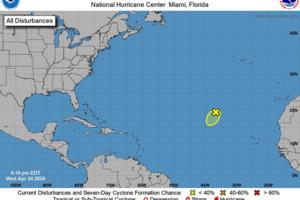
Hurricane center watching blip in Atlantic. No threat but hints at busy season ahead
MIAMI — The National Hurricane Center is already watching something in the Atlantic, and it’s only April.
The low-pressure area in question is a thousand miles away from inhabited land and expected to dissolve in the next few days, but it’s also a reminder that the upcoming hurricane season is poised to be an active one.
The season ...Read more

In 12 years Texas will be hotter than any year to date, see deadlier wildfires, study says
FORT WORTH, Texas — A new report on the future of extreme weather in Texas says the state is in store for hotter temperatures, increased severity of droughts and growing wildfire risks.
The report from John Nielsen-Gammon, Texas State Climatologist at Texas A&M University, is an updated 2024 version from his original 2021 report titled, “...Read more
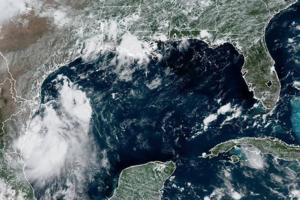
Get ready for one of the busiest Atlantic hurricane seasons on record, forecasters say
PHILADELPHIA — The 2024 Atlantic hurricane season is likely to be destructive and costly and has the potential to be one of the busiest on record.
That's the consensus of several major forecasting services, all of which point to conditions in the tropical Pacific and in the Atlantic hurricane-formation zone that are ripe for a tropical-storm ...Read more
Dubai's record rain floods expensive homes and halts flights
Dubai flights have been severely disrupted and cars were left stranded on flooded roads after record rainfall over the past day brought the city to a standstill.
The United Arab Emirates experienced its heaviest downpour since records began in 1949, Dubai’s media office said in a statement. It caused chaos for residents as water entered the ...Read more

How strong was tornado that struck Mississippi Coast? Here's the path, wind speed & damage report
BILOXI, Miss. — A storm system that beat through the Mississippi Coast on Wednesday created a 110 mph tornado that cut a four-mile path through Harrison County, the National Weather Service confirmed Thursday.
The tornado, which the NWS classified as EF1, first touched down at 10:30 a.m. near Cleveland Ladner Road and River Road northeast of ...Read more
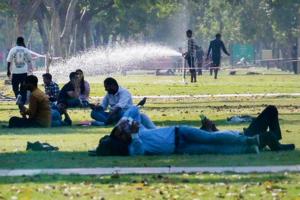
World hits 10th consecutive month of record-high temperatures
March was the Earth’s 10th consecutive month of record-breaking heat, with populations across much of the northern and southern hemispheres experiencing temperatures overshooting climate targets.
The European Union’s Copernicus Climate Change Service reported Tuesday that record March temperatures globally were 1.68 degrees Celsius (3 ...Read more

Xcel shuts power off for 55,000 customers due to high wind, fire danger in Colorado
DENVER — Xcel shut off power to 55,000 Colorado customers across six counties Saturday for a controlled outage planned to last more than 24 hours, citing the dangerous wind conditions and wildfire risks this weekend.
Some of the energy company’s customers in Boulder, Gilpin, Larimer, Douglas, Broomfield and Jefferson counties will see ...Read more

Massachusetts pounded by wicked nor'easter; solar eclipse forecast looks 'really favorable'
Hopefully a lot of April showers bring a lot of May flowers.
A nasty early spring nor’easter pounded the region with snow, sleet, rain, wicked strong winds and coastal flooding on Thursday.
The storm sparked tens of thousands of power outages across Massachusetts, and vehicles were spinning out on the roads as police responded to numerous ...Read more
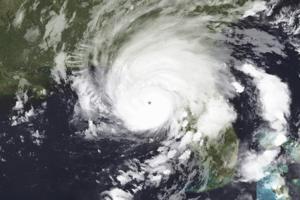
Steamy ocean means 'a very, very busy season' for hurricanes, early forecasts say
The upcoming hurricane season is shaping up to be another extremely active one, powered by the Atlantic’s record-breaking run of high temperatures.
The early season forecast from Colorado State University — a key pioneer of preseason hurricane forecasting — calls for another above-average season. The bottom line: Florida, and other ...Read more
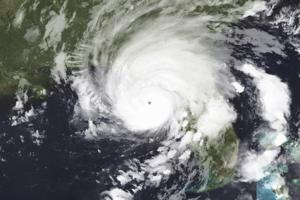
Steamy ocean means 'a very, very busy season' for hurricanes, early forecasts say
The upcoming hurricane season is shaping up to be another extremely active one, powered by the Atlantic’s record-breaking run of high temperatures.
The early season forecast from Colorado State University — an early pioneer of preseason hurricane forecasting — calls for another above-average season. The bottomline: Florida, and other ...Read more

8 tornadoes plow through Kentucky, leaving 1 dead and thousands without power
LEXINGTON, Ky. — The National Weather Service has confirmed eight EF-1 tornadoes touched down in Kentucky during Tuesday’s storm.
Around 4 p.m., the National Weather Service Wilmington, Ohio, office confirmed an EF-1 tornado struck in Mason County along the Ohio border. The tornado started near Minerva, Kentucky, and lifted around the Ohio ...Read more

Gov. Gavin Newsom surveys California snowpack, unveiling water plan for an uncertain future
Surrounded by a blanket of snow, Gov. Gavin Newsom donned snowshoes Tuesday to observe officials surveying this year’s snowpack and unveil a new California water resources plan that factors in climate realities.
The snowpack across the state was measured at a little above average — a rarity after recent swings between extreme drought and ...Read more
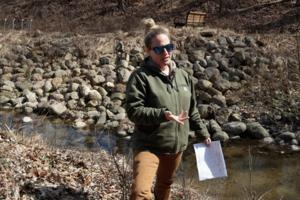
Great Lakes ice cover hits record low through mid-March of this year
HIGHLAND PARK, Ill. — The sun beat down as Liz Ricketts peered over a wooden bridge on Rosewood Beach in Highland Park. Below her, a narrow stream carved through the sand, flowing from a grove of barren trees into Lake Michigan.
Through the murky water, littered with leaves, she spotted two rainbow trout lingering along the riverbed. They ...Read more
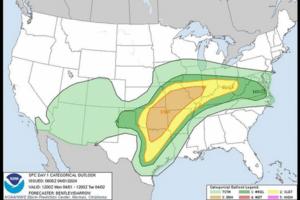
Dangerous thunderstorms threaten KC area as severe weather possible over most of Missouri
Dangerous storms that are likely to fire up across the middle part of the United States could bring strong to severe storms to the Kansas City area Monday afternoon, according to the National Weather Service in Kansas City.
Warm, muggy air is expected to expand into Kansas City and continue north to the U.S. 36 highway in central Missouri, the ...Read more
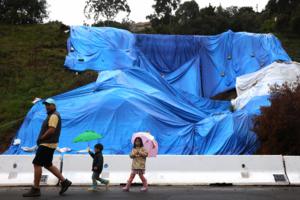
Wet weather forecast for Easter as late-season storm moves through LA area
LOS ANGELES — After a late-season storm brought reports of flooding on Los Angeles freeways and a tornado warning in Santa Barbara County, a wet Easter Sunday is in the forecast for Southern California.
Up to 2 inches of rain is expected to hit Los Angeles County's foothills and mountains over the next 24 hours, with the storm lingering over ...Read more
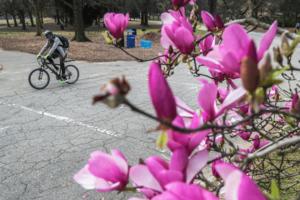
Pollen counts in Atlanta reach “extremely high” levels
Warm spring days in Atlanta can be lovely but the allergy season can make life miserable for those who suffer from seasonal allergies.
And at the moment, the pollen count for tree pollen in Atlanta has soared to “extremely high” levels, according to the latest measurements released Friday by the Atlanta Allergy & Asthma’s pollen counting ...Read more

A 'potentially explosive' hurricane season is coming, predicts AccuWeather
FORT LAUDERDALE, Fla. — AccuWeather on Wednesday released its seasonal forecast, predicting a “potentially explosive” hurricane season this summer and fall.
The season runs June 1 to the end of November, but there is the potential for tropical systems — storms that gain their energy from hot sea surface temperatures as opposed to a ...Read more

Rains in Philly set 2 records, and flood warnings remain in effect
PHILADELPHIA — March days around here have been snowier, icier, colder, warmer and certainly more traumatic, but none has been as wet in Philadelphia as March 23, 2024.
By midafternoon, 3.09 inches of rain had been measured officially at Philadelphia International Airport, the highest total for a March day in 150 years of record keeping. It ...Read more
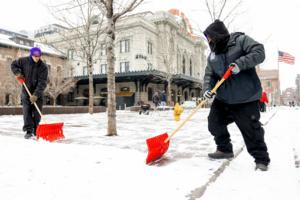
Colorado weather: Warm spring temps will turn into weekend snowstorm
Will Sunday bring about a repeat of last Thursday’s snowstorm? It’s too soon to say, but winter weather is once again on the way to Colorado.
Although warm weather will continue in the Denver area Friday — with high temperatures hovering in the mid- to high-60s — snow will already be starting in the mountains Friday night, according to ...Read more
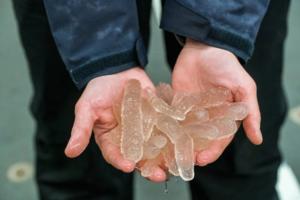
Blobby creatures washed up on West Coast beaches during marine warming, sucking up energy
During recent marine heat waves, millions of gelatinous, pickle-like filter feeders washed up on West Coast beaches.
Little has been understood about how the population explosion of the seemingly alien creatures, called pyrosomes, affected life in the Pacific Ocean.
But a new study shows the proliferation of the animals might have sucked up ...Read more
Popular Stories
- Hurricane center watching blip in Atlantic. No threat but hints at busy season ahead
- In 12 years Texas will be hotter than any year to date, see deadlier wildfires, study says
- Get ready for one of the busiest Atlantic hurricane seasons on record, forecasters say
- Dubai's record rain floods expensive homes and halts flights
- How strong was tornado that struck Mississippi Coast? Here's the path, wind speed & damage report





